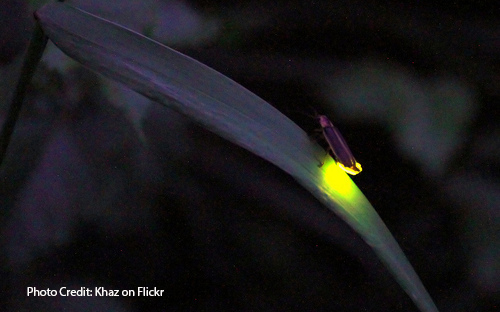We share our city spaces with many nocturnal creatures. From the fireflies that illuminate the night, to the owls that silently stalk the skies – there is a lot of activity in the nighttime forest. Finding food, water, shelter, and space in the dark isn't always easy – but with amazing adaptations, nocturnal animals fill the nighttime niche in ecological communities. Here are a few examples of nocturnal adaptations:

There are over 100 species of lightning bugs illuminating the night sky. Lightning bugs are the only insects that are bioluminescent (a chemical reaction creates light within an animal) in a distinct pattern. The amazing lightning bug flashes these distinct patterns to communicate with other lightning bugs of the same species.
 Owls can rotate their heads an impressive 270º! Why? Because they can't move their eyes. Owls' eyes are huge in comparison to their heads, which allows them to collect as much light as possible at night, but doesn't allow room for the muscles that move the eye sockets. So, in order to have the best of both worlds – large, light collecting eyes and a broad range of vision – owls have amazing flexibility in their first vertebrae!
Owls can rotate their heads an impressive 270º! Why? Because they can't move their eyes. Owls' eyes are huge in comparison to their heads, which allows them to collect as much light as possible at night, but doesn't allow room for the muscles that move the eye sockets. So, in order to have the best of both worlds – large, light collecting eyes and a broad range of vision – owls have amazing flexibility in their first vertebrae!
 Although bats do have good vision, it's not that useful at night for pursuing the flying insects that Wisconsin bats feast on after dark. Instead, our insect-eating bats use echolocation to locate and catch prey. The bat sends out a steady signal of very short, high-pitched sounds that we can't hear. It scans the area, turning its head from side to side, sending out sound pulses through its mouth. The sounds bounce off objects and return to the bat as echoes. As the bat gets closer to an insect, it sends out more squeaks. These sounds continue to bounce back to the bat's large, sensitive ears until it can tell exactly where the insect is located.
Although bats do have good vision, it's not that useful at night for pursuing the flying insects that Wisconsin bats feast on after dark. Instead, our insect-eating bats use echolocation to locate and catch prey. The bat sends out a steady signal of very short, high-pitched sounds that we can't hear. It scans the area, turning its head from side to side, sending out sound pulses through its mouth. The sounds bounce off objects and return to the bat as echoes. As the bat gets closer to an insect, it sends out more squeaks. These sounds continue to bounce back to the bat's large, sensitive ears until it can tell exactly where the insect is located.
Nocturnal animals are often secretive and incongruous, but they are also important members of our urban communities. Bats and owls help control insect and rodent populations, and some nocturnal insects, like moths help pollinate many beneficial plants.
Come to the Enchanted Forest and learn more about adaptations for thriving in the dark and how other nocturnal animals fit into the urban environment!
The allure of lights reflecting off the water, delicious aromas drifting from restaurants and the rhythmic sounds of music, chatter, and laughter make for enchanting city nights. But the dark and quiet natural spaces in our city are quite enchanting too. In these spaces, there are things happening above your head, below your feet and before your eyes. Forests are inherently enchanting places, but on the evening of October 26th the enchantment in the forest at Riverside Park will amplify as the nocturnal inhabitants of the forest emerge to share their stories at the Enchanted Forest.





